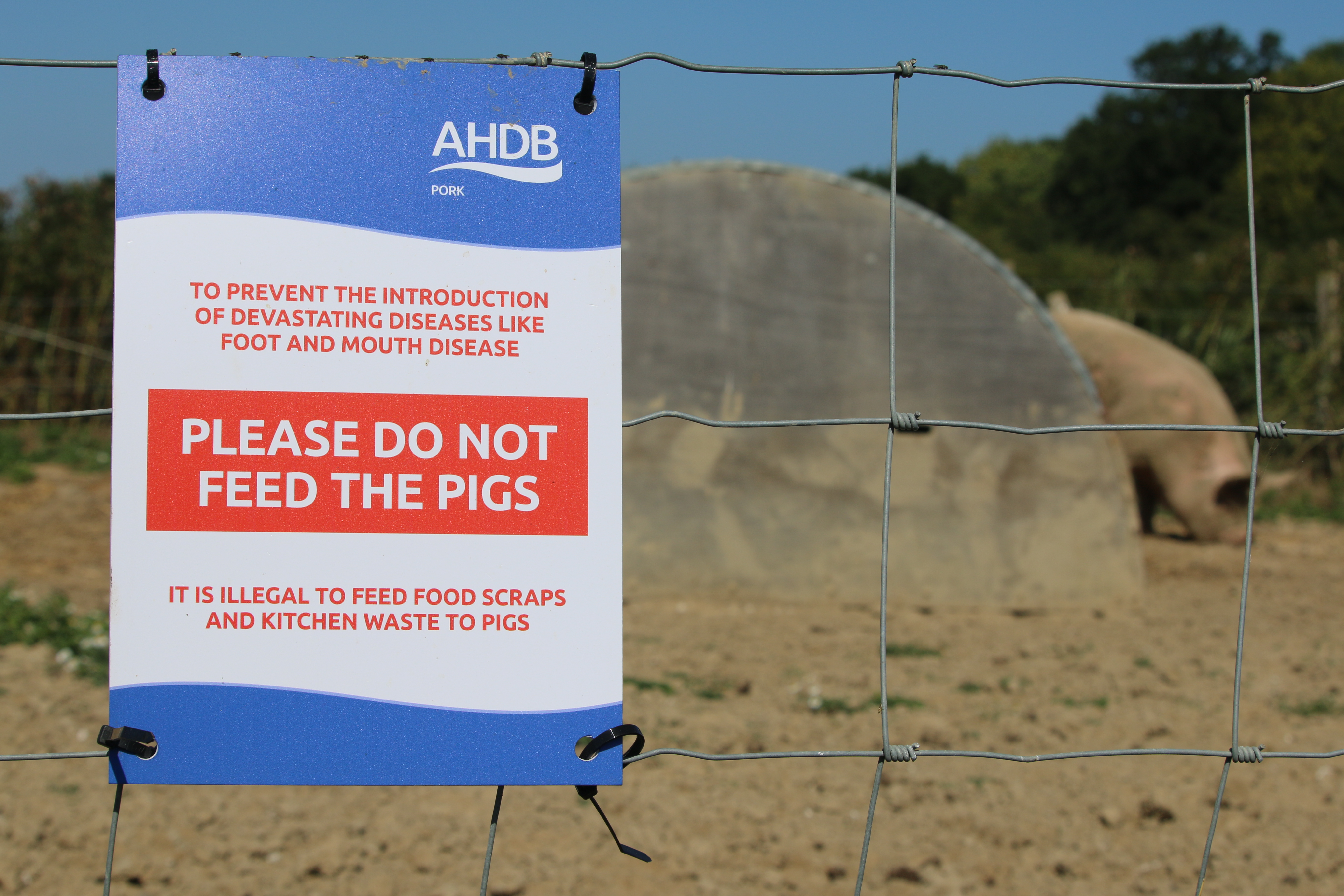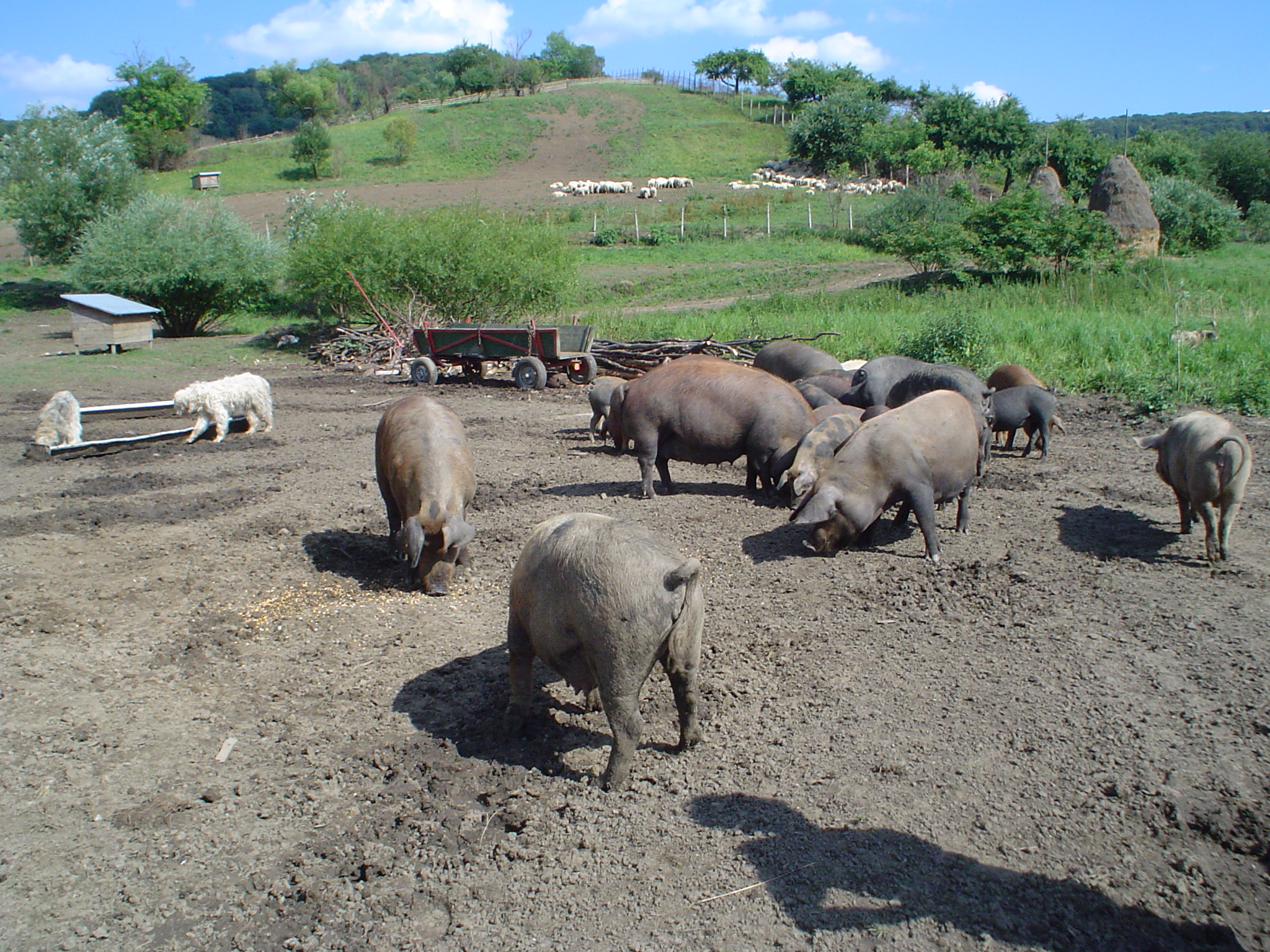



Characterising outdoor pig production in Europe
A variety of outdoor pig production systems are present in the EU but are these more open systems playing a part in the movement of African swine fever in Europe?Part of Series:
< Previous Article in Series Next Article in Series >
In the EU, the rearing of pigs outdoors is banned in ASF affected countries but as the virus spreads further, free-range and outdoor herds are being investigated in countries where the virus has not yet been confirmed. Based on literature research and on questionnaires on outdoor production in 12 European countries (Belgium, Estonia, Finland, Germany, Italy, Latvia, Norway, Serbia, Slovenia, Spain, Sweden and the Netherlands), ASF-STOP and COST have characterised outdoor production in Europe.
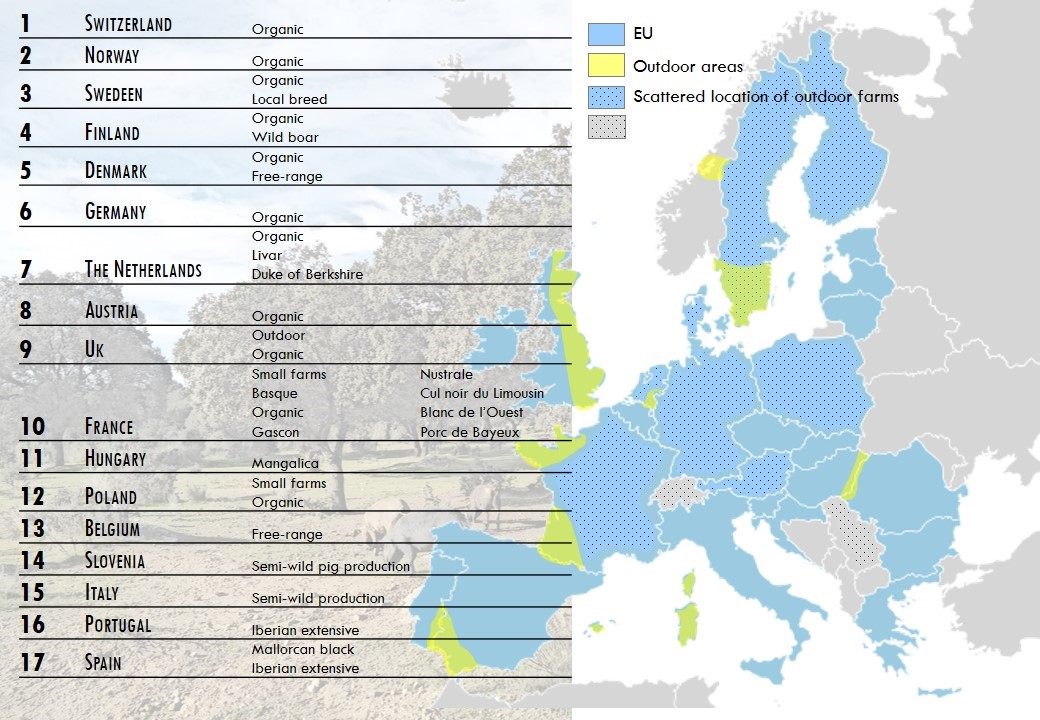
© ASF-STOP
Organic (EU countries, Norway and Switzerland)
In many countries, outdoor pig production is predominantly organic. Organic production is very well regulated by EU legislation but varies by country. Sows are typically kept in outdoor systems, whereas weaned pigs are usually kept indoor swith access to an outdoor yard. Minimum outdoor yard space requirements summarised by Borell and Sørensen (2004), based on the regulation, are:
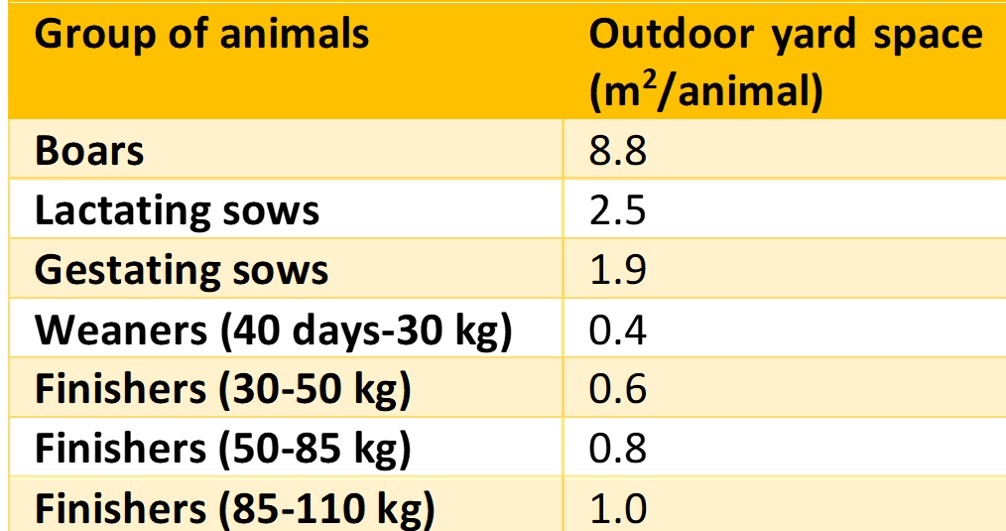
Organic pig production does not represent the majority of production and its expansion in recent times is limited compared to the expansion observed in dairy and beef production systems (Borell and Sørensen, 2004). Among other reasons, it has been linked to a high risk of disease spreading in outdoor housing.
In Germany, outdoor holdings/farms are by law required to obtain written permission from the local veterinary authority and are required to fulfil a defined set of biosecurity measures aimed to avoid interaction between wild boar and domestic pigs. Therefore, at the district level, these farms are known to the authorities and the permission for outdoor production can be withdrawn if circumstances require this measure.
In Denmark, all farrowing sows and piglets are kept outdoors on pasture all year in individual paddocks with huts. The pregnant sows have to be on pasture for a minimum of 150 days/year. Regarding weaning and fattening pigs, most are kept indoors with concrete outdoor runs.
In Austria, pigs are housed mainly indoors with a concrete outdoor run. Although outdoor runs are required by the EU regulation, there is derogation for specific situations.
In France, pregnant sows are generally kept outdoors in huts. Around 80 percent of the farrowing is outdoors, in huts, and 20 percent indoors, in stables. Weaners are kept outdoors or in stables and fatteners are mainly indoors with outdoor access.
In the UK, most production stages in organic systems are outdoor on pasture. A national certifying body establishes that animals should be kept at pasture throughout the year in rotational grazing systems.
In Sweden, two percent of the production is organic and the pigs at these farms are required to stay outdoors during the warm season (not during winter). In organic production systems, sows and growers must have access to the outdoors, at least during the warm season of the year. Most pigs are housed indoors during winter, with access to a concrete outdoor run. During summer, the sows are housed outdoors in huts on pasture or in stables with access to pasture. In some of the quality systems, access to a concrete floor just outside the barn may be enough, while access to pasture for rooting is required in other quality systems. Although still uncommon, conventional holding of fattening pigs have introduced dunging areas with slatted floors in balconies outside the stable. The walls to these balconies are solid, which decrease the risk for nose to nose contact with wild fauna.
In the Netherlands, outdoor pig producers can raise their pigs in either certified free-range or biologically farmed conditions. Pigs are closely monitored with regards to their fed and housing conditions. Biological farms are also at higher risk due to the presence of other domesticated animals (cats, dogs), which could also contribute to the spread of disease.
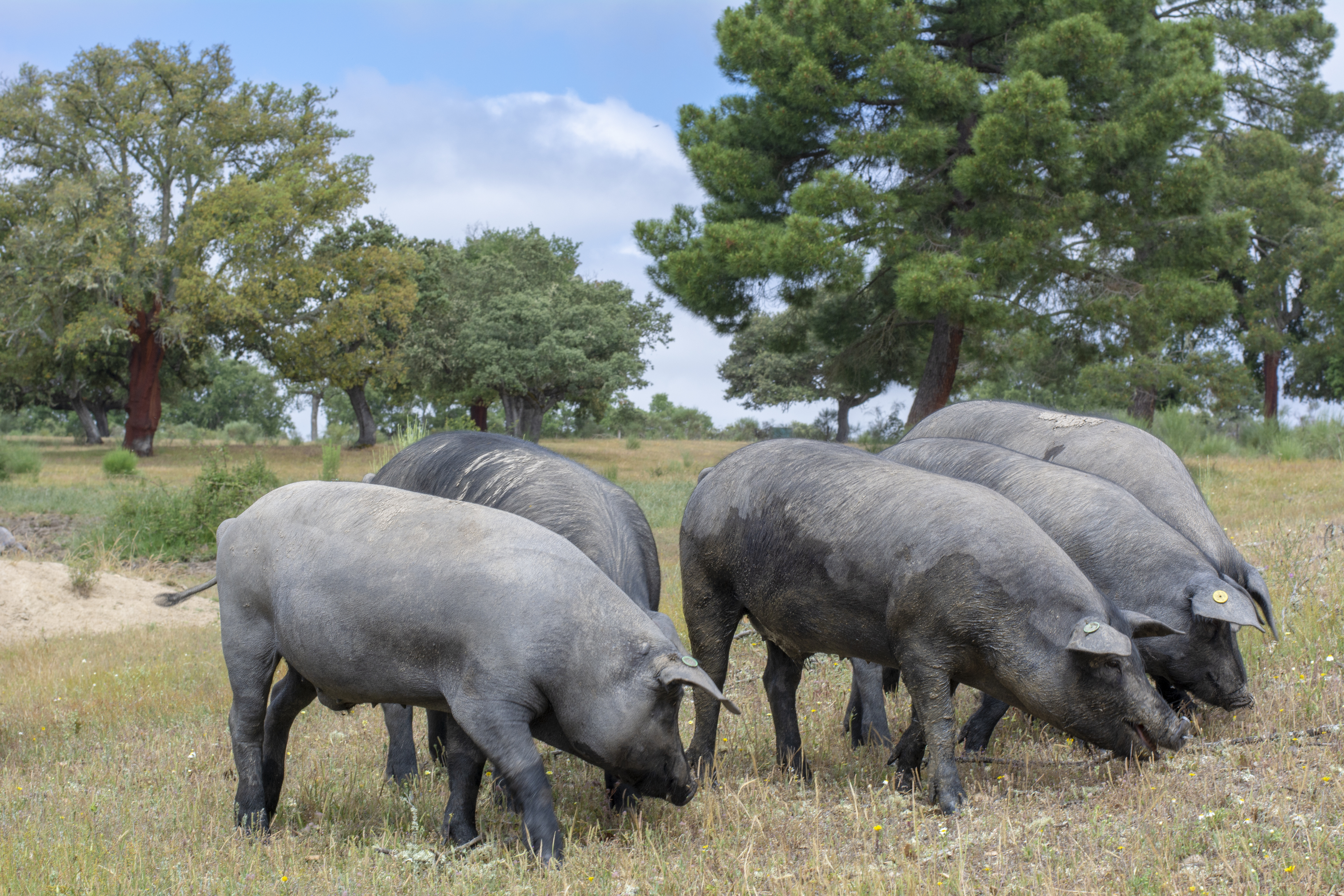
Iberian pigs (Spain and Portugal)
The native Iberian pig breed uses the natural meadowland resources of pastures and acorns for at least 60 days of its life. This breed is widespread in the south-west of the Iberian Peninsula. In Spain - with regards to the census - extensive systems only make up 5 percent of the national pig herd but are representative of Spain’s commercial outdoor production. Other extensively-reared pigs are located predominantly in northern Spain and the Balearic Islands and generally make use of local breeds, which effectively use natural resources.
Semi-wild pig production (Sardinia, Italy)
Semi-wild pig production is more common in Eastern European countries and in Sardinia.
In Sardinia, raising pigs outdoors is a traditional method of husbandry in the mountainous and hilly areas where pigs are kept on communal land. These herds can range from 2 to 300 pigs. Pigs graze on vast publicly-owned areas during the entire year or, in case of partial confinement, the animals graze on public areas during the fall, to utilise acorns produced by evergreen oaks, and are kept indoors for the rest of the year. Animals belonging to different herds can share the same grazing areas and they can co-mingle with wild boar. For most pig producers in Sardinia, pig production is a secondary income-producing activity. Indeed, approximately 70 percent of these farms raise more than one animal species on the same land (Mur et al, 2014).
In Sardinia, ASF has been present since 1978 and grazing free-range herds is considered a major obstacle to disease control. This is why in Sardinia it is currently forbidden to keep pigs outdoors.
Backyard pigs (Slovenia)
In Slovenia, the pig industry involves traditionally small pig farms with less than 50 breeding sows. Some of them are backyards where pigs are reared outside in a fenced area. The number of backyard pigs is unknown. These backyard pig operations might be a potential risk for the introduction and spread of diseases from wild boar to domestic pigs, even more so, since wild boar are present all over Slovenia.
Free-ranging (Belgium)
In Belgium there are 147 outdoor herds with capacity for 12,269 pigs (2,100 pigs each). Pigs graze in confinement, particularly in Wallonia where mixed breed piglets (wild boar x domestic pig) are common.
Farmed wild boar (Finland)
There is a small percentage of wild boar farms in the country (about 120 farms). They are fenced because they may attract wild boar in the wild for example during the breeding season. People who keep wild boar operate quite independently; it is more difficult to reach the farm owners and give information about ASF (compared to conventional pig farms that are well organised and connected to the industry).
Compared to the EU, the characteristics of the outdoor pig production system in other European countries are different. Norway, Switzerland and the Balkan Peninsula are presented as an example.
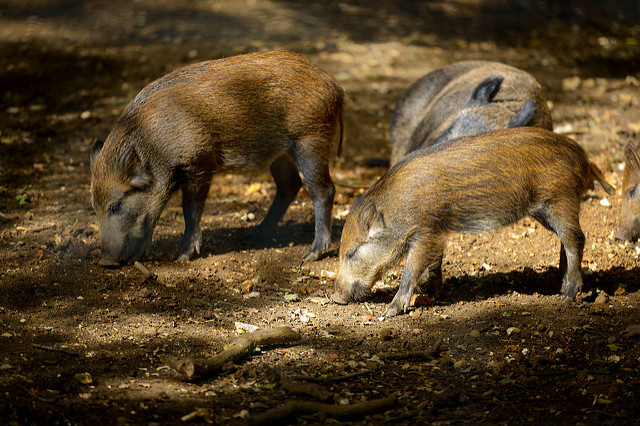
Norway and Switzerland
In Norway, there are very few outdoor commercial pig production holdings (approx. 20-30 holdings). In outdoor sow herds, the typical housing system is huts on fenced pastures or mixed housing systems. In finisher herds, the typical housing is fenced pastures or mixed housing systems. The production of captive wild pigs is small to negligible in size, but the exact number of pig holdings with captive wild pigs is unobtainable due to shared production animal holding registration codes with domestic pig production. There are approx. 700 non-commercial pig holdings in Norway. The exact distribution of housing types (outdoor/indoor) of the non-commercial pig holdings are unobtainable, but likely many have a combination of outdoor and indoor housing.
In Switzerland, the proportion of the organic pig production is about 1.0 percent of the national pig production. Farrowing, weaning and fattening is indoors (about 95 percent) with a concrete outdoor run. Sows in gestation have access to pasture or a concrete outdoor run with the possibility to dig. Sows, piglets, weaners and fatteners have access to an outdoor run (always concrete floor).
Balkan Peninsula
In the Western Balkans countries (Republic of Serbia, Former Yugoslav Republic of Macedonia, Montenegro) the outdoor pig production is widely distributed in villages, near the rivers, and in local forests. Actually, sometimes it is hard to differentiate between backyard and outdoor production systems (because the backyard herds do not have a complete fence, and the pigs are not enclosed). One of the characteristics of outdoor swine production in some regions is raising free-roaming domestic pigs, where they share forest habitat with the wild boar. It is also important that the owners of the outdoor production units in the same time have backyard pigs (Prodanov-Radulović et al., 2018a).
It is characteristic that the outdoor pigs do not have any restriction of contact with the populations of wild boar and/or domestic pigs originating from different owners, regardless of the epidemiological situation in the region (for instance Classical swine fever). The largest pig producer is currently Serbia, and followed closely by the other two countries. According to the official data, outdoor pig production system in Serbia is 0.1 percent in total (in numbers- 214 units of outdoor pig production system) (Statistical Yearbook of Republic of Serbia, 2017; Prodanov-Radulović et al., 2018b). However, a similar official estimate from other two countries is missing. There is no official data about outdoor pig production systems in Montenegro (Statistical Yearbook of Montenegro, 2017) or in Macedonia (Republic of Macedonia, Statistical Yearbook, 2018). By the data of Ministry of Agriculture and Rural Development, pig production in Montenegro is a weak sector, with expressive fluctuations during the year primarily due to lack of suitable areas for cereals production for pig feed. According to MONSTAT Agriculture Census of June 2010, the total number of pigs was 47,673. Fattening of pigs is largely performed in family households for their own consumption.
The import of fattening pigs from Serbia equals to 20,000 each year. The majority of meat is produced in small units, while family holdings fatten piglets for their own purposes. In the FYROM, independent producers produce around 60 percent of the total pig herd. These producers keep around 4 to 5 fattening pigs and/or 1 to 3 sows. Domestic production covers around 70 percent of the domestic demand for pork meat. The remaining demand is covered by imports from EU (62 percent), Brazil (11 percent) and Poland (4 percent).
Organic, outdoor pig farming is officially present also in Serbia. The herd size of organic pig farms varies, but there are usually around 35-50 pigs per herd. The organic farms usually include old domestic race (Mangulica breeds), which are historically linked to this region and the meat products (bacon, ham, sausage) are quite popular. The organic farms are actually outdoor production units, having not more than simple fragile fence and a separated fenced area for grazing. They are usually located outside of the village, and away from the main roads, at the river banks. On this type of farm, the owner quite frequently also breeds cattle, goats and sheep. The products from this type of pig farm are very popular and are commonly labelled as healing products. The ham and bacon from this type of farming is considered to be healthy food.
Free-range pigs are usually settled in the forest and the herd size varies, but usually we can find up to 250 domestic pigs located in the local public areas from Spring to Fall. Some animals stay permanently in the wood but most of them are transported to the village and then they join the rest of the backyard pigs. This kind of pig production is officially recognised, all free-range animals have ear-tags and they have to be vaccinated against CSF.
| References | ||||
|---|---|---|---|---|
| Boinas, F.; Ribeiro, R.; Madeira, S.; Palma, M.; de Carvalho, I.L.; Nuncio, S.; Wilson, A.J. | ||||
| (2014) | The medical and veterinary role of Ornithodoros erraticus complex ticks (Acari: Ixodida) on the Iberian Peninsula.. Journal of Vector Ecology | 39 (2): 238-48 | ||
| Boinas, F.; Wilson, A.J.; Hutchings, G.H.; Martins, C.; Dixon, L.J. | ||||
| (2011) | The persistence of African swine fever virus in field.infected Ornithodoros erraticus during the ASF endemic period in Portugal.. PLOS One | |||
| Bonneau, M.; Antoine-Ilari, E.; Phatsara, C.; Brinkmann, D.; Hviid, M.; Groes Christiansen, M.; Fàbrega, E.; Rodriguez, P.; Rydhmer, L.; de Greef, K.; Edge, H.; Dourmad, J-Y.; Edwards, S. | ||||
| (2011) | Diversity of pig production systems at farm level in Europe.. Journal on Chain and Network Science | 11 (2): 115-135 | ||
| Borell, E.V; Sorensen, J.T. | ||||
| (2004) | Organic livestock production in Europe: aims, rules and trends with special emphasis on animal health and welfare.. Livestock Production Science | 90 (2004) 3–9 | ||
| European Commission | ||||
| (2018) | Working document on Strategic approach to the management of African Swine Fever for the EU. | SANTE/7113/2015 - Rev 10. | ||
| Früh, B., Bochicchio, D., Edwards, S., Hegelund, L., Leeb, C., Sundrum, A., Werne, S., Wiberg, S. and A. Prunier | ||||
| (2014) | Description of organic pig production in Europe.. Organic Agriculture | 4:83-92 | ||
| Mur, L; Atzeni, M; Martínez-López, B; Feliziani, F; Rolesu, S; Sanchez-Vizcaino, JM | ||||
| (2013) | Thirty-five-year presence of African Swine Fever in Sardinia: history, evolution and risk factors for disease maintenance.. Transboundary and Emerging Diseases | e165-e177 | ||
| Prodanov-Radulović J, Pušić I, Živkov-Baloš M, Polaček V, Stojanov I, Marčić D, Bojkovki J. | ||||
| (2018a) | Application of biosecurity measures in swine production - field observations.. International Scientific Conference on Green Economy and Environment protection. | pp.136-137 | Book of Abstracts, Belgrade, Serbia | |
| Prodanov-Radulović J., Polaček V., Molnar T., Živulј A., Martinov R., Filipović S., Šubarević N., Tomić A., Debelјak Z. | ||||
| (2018b) | Determination of existing biosecurity risk on pig farms. | pp.100-101. | Book of abstracts, XX epizootiological days, Beograd, SVD | |
| Tomanović S, Radulović Ž, Milutinović M, Čakić S, Mihaljica D, Tselentis Y, Psaroulaki | ||||
| (2013) | Analysis of pathogen co-occurrence in host-seeking adult hard ticks from Serbia.. Experimental and Applied Acarology | 59, 3, pp 367–376 | ||
| Wilson, A.J.; Ribeiro, R.; Boinas, F. | ||||
| (2013) | Use of a Bayesian network model to identify factors associated with the presence of the tick Ornithodorus erraticus on pig farms in southern Portugal.. Preventive Veterinary Medicine | 110 (2013): 45-53 |









